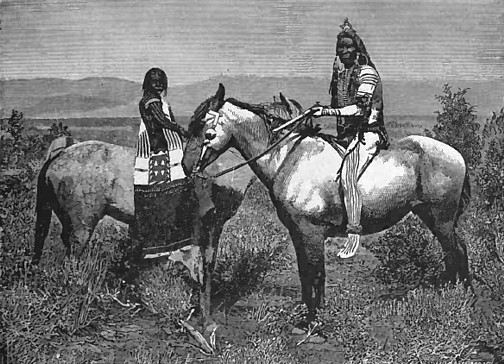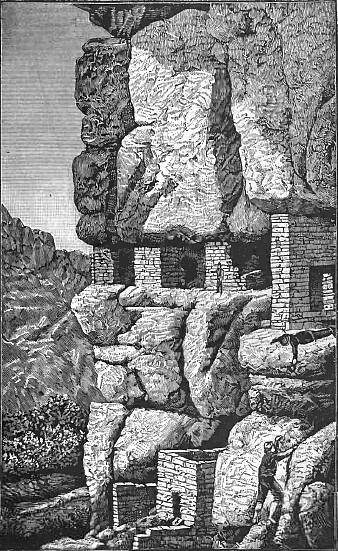The evidences of an ancient civilization which are met with in the ruins scattered throughout the Territory, have long been a subject of earnest inquiry among savants and explorers. The character and extent of these ruins prove conclusively that the region now known as the Territory of Arizona was, at some period in the past, the seat of a civilization much further advanced than that which occupied the land when first discovered by Europeans. First among these prehistoric relics, both in its extent and state of preservation, is the Casa Grande, about six miles below Florence, in the valley of the Gila, and about five miles south of that stream. This ruin was discovered by Coronado's expedition in 1540. It was then four stories high, with walls six feet in thickness. Around it were several other ruins, some with the walls yet standing, which have since succumbed to time and the elements. The Pima Indians, who, then as now, were living in the immediate vicinity, had no knowledge of the origin or history of the structure. It had been a ruin as far back as tradition extended in their tribe, and when or by whom erected was as much a mystery to the dusky natives as to their European visitors. Father Pedro Font examined the Casa Grande in 1775, and describes the main building as " an oblong square, facing to the cardinal points of the compass. The exterior wall extends from north to south four hundred and twenty feet, and from east to west two hundred and sixty feet.
The interior of the house consists of five halls, the three middle ones, being of one size, and the extreme ones longer. The three middle ones are twenty-six feet in length from north to south, and ten feet in breadth from east to west, with walls six feet thick. The two extreme ones measure twelve feet from north to south, and thirty-eight feet from east to west." At present the ruins are about two stories high, and are rapidly crumbling away. The walls are composed of a material looking like concrete or grout. The dimensions of the ruin still standing are about 50 by 30 feet. It is divided into many small rooms, and plastered with a reddish cement. The walls still show small round holes where the rafters had entered, charred pieces of which are yet found imbedded in the adobe. The interior room is the largest, and is still in a fair state of preservation. All around the main building are mounds and traces of ruins, which go to show that a large city existed here at one time. The course of an immense irrigating canal, which watered the plain where the ruins now stand, has been followed to the Gila above Florence, forty miles distant.
Near Tempe, in the Salt-river valley, are found the ruins of extensive buildings, which are supposed to have been even larger than the Casa Grande. The foundations of one have been traced, which measures 275 feet in length and 130 feet in width. Excavations made in these mounds have brought to light several ollas which were filled with charred bones. The remains of a large irrigating canal are traced near the ruins.
The road from Phoenix to Tempe follows the bed of the ancient water-course for a considerable distance; it is much larger than any in use by the modern occupants of the valley. The ruins of canals and buildings which are yet found in the plain between the Gila and the Salt rivers go to show that this region, now so desolate, was at one time thickly inhabited. At many other points in the Salt-river valley the marks of a civilization which once flourished here and made the desert to smile with industry, are yet plainly traced. All about the ruins are found fragments of pottery, painted in various colors and highly glazed. In the valley of the Upper Gila, known as Pueblo Viejo, are found extensive mounds similar to those of the Salt river. Traces of buildings, irrigating canals, broken pottery, etc., are met with in every direction. Ruins of a like character are encountered at different points all along the Gila river. On the San Pedro, near its junction with the Gila, are remains of what must have been a large city. The foundations were of stone, laid in a coarse cement. Numerous ruins are found along the Verde and its tributaries, in the Agua Fria valley, and in the mountains and valleys extending for fifty miles in every direction from Prescott. Some of the structures on the Verde and Beaver creek, are among the most interesting in the Territory.
On a hill overlooking the river, below Chino valley, is a series of ruins of stone houses; on another hill, about three miles east, are found the remains of many other stone buildings. In the valley of the Verde, traces of its early inhabitants are found in every direction. Opposite Camp Verde are a number of stone ruins, overlooking the river. Two miles down the stream, on an elevated mesa, an ancient burial ground has been discovered. On Beaver creek, a tributary of the Verde, are found many interesting cave dwellings. They are walled up in front, and look like the rocky bluffs out of which they have been excavated. Cisterns made of cement, and in a remarkable state of preservation, are found near many of these dwellings. One of these caves is eighty feet across its front, and nearly one hundred feet above the base of the cliff. The interior is divided into many rooms, the height of the roof being about fifty feet. The wall in front is pierced by two loopholes, through which a view of the country for some distance around, can be had.
In Chino valley, twenty miles north of Prescott, are found many interesting stone ruins. Large ollas, filled with charred corn and beans, have been unearthed from these mounds. Several skeletons have been discovered, and also a number of stone hammers and axes. There is every reason to believe that the inmates died by violence, the doors and windows being walled up, evidently as a protection against a hostile foe. In the vicinity of Walnut Grove, twenty-five miles south of Prescott, are found the ruins of large stone structures crowning elevated mountain-tops, some of them from twenty to thirty feet square. On the Hassayampa, and the mountainous country south from Prescott, these ruins are numerous, and were evidently built on their commanding positions by people who were constantly harassed by savage foes. That the bed of the Hassayampa has been washed for native gold in ages past, is proven by the large pines, whose age is numbered by hundreds of years, found growing where the ancient miner once searched for the precious metal. Prescott, the modern capital of Arizona, occupies, it is believed, the site of an ancient city, and many relics of its former inhabitants which have been brought to light, go to strengthen this theory.
Near Fort McDowell are found the remains of a large fortification, and of an immense irrigating canal. The bones of a man, supposed to be seven feet high, were unearthed near this point. On the Rio Bonito and other branches of the Salt river, numerous cave dwellings are found. The Colorado River valley exhibits traces of mounds and irrigating ditches, showing that this region was at one time densely populated. All over the Territory, north from the Casa Grande on the Gila, and extending into New Mexico and Southern Colorado, the ruins of stone buildings, large towns, cave dwellings, and immense canals are met with in the valleys and on the mountain-tops and hillsides, near the principal water-courses.
Nothing is left to tell the story of the people who constructed them, save the few earthen vessels which have been found in the ruins, the stone hammers and axes occasionally met with, and the fragments of broken pottery which lie scattered about their former abode. From the charred remains of human bones taken from the ruins, it has been supposed that the ancient people cremated their dead; and, from the few hieroglyphics which they have left behind, it has been thought they were sun worshipers.
As to their pursuits and mode of life, it is generally believed they followed the business of mining, as well as agriculture. As has been before alluded to, the evidence is conclusive that many of the gulches in the Sierra Prieta range were worked for the golden treasures hundreds of years ago. That this ancient race, who have left such massive monuments of their skill and industry behind them, had made rapid progress in the arts of an advanced civilization, there can be no doubt. Who were those people who erected imposing structures, opened canals, and brought immense stretches of land under cultivation? From whence did they come, and what has been the cause of their extinction, so complete that nothing is left to tell the story? Many theories have been advanced as to their origin and history, but nothing definite is yet known of one of the most remarkable of prehistoric races of the American continent. Here is a wide field for the savant who desires to trace the evidences of a civilization whose origin is lost in the mists of antiquity, and whose crumbling monuments yet proclaim its ancient vigor and wide extent. Perhaps the key to unlock the barred and bolted chambers of prehistoric American history may yet be found in the ruins of Arizona.
Return
to The Arizona Page:
Arizona Gold Rush Mining History



